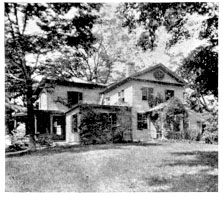A Glimpse of Williamstown.
a rural but cultivated home Miss Sedgwick passed from infancy to girlhood, from girlhood to womanhood, while that character was developing which seemed to have taken its color from the beauty of the hills around her. Many descriptive bits of Berkshire scenery abound in "The New England Tale," "Hope Leslie," and "The Linwoods," three of the best of her books. Monument Mountain, Laurel Hill, the Housatonic, all have their associations. It is, however, in the faithful pictures of early New England village life that her novels chiefly interest us. We are shown the Puritan stillness that follows the going down of each Saturday's sun, the peacefulness of Sabbath morning, the peal of the church-going bell, the minister and 'squire with solemn mien upon the way, the farmer invariably riding, his blooming daughter, all in white, with leghorn hat, fan, and parasol, alighting nimbly at the church steps. Then, as the Sabbath begins to wane, there is a wandering of children's eyes from the catechism toward the western sky; and when the sun's orb reaches the horizon, penance is over and laughter and tumbling possess the village green. Although, as Mr. Richardson justly says, "Miss Sedgwick is more respected than read to-day," her works will still continue as valuable pictures of early life among the "hill towns" of Berkshire. Miss Mary E. Dewey, the daughter of Dr. Orville Dewey, of Sheffield, is her loving biographer.
About the time Miss Sedgwick began her literary career, a youth of twenty came over the hills from Cummington, his native place, to commence law practice at Great Barrington, as the youth planned, but to usher in the dawn of American poetry, as Fate willed. Eight months earlier this same youth, would-be poet, unwilling barrister, had gone to Plainfleld on a like errand. The sight of a solitary bird winging along the shadowy horizon called forth that night, in the loneliness of his bedchamber, those memorable lines, "To a Water Fowl." "Thanatopsis," "The Yellow Violet," and the "Fragment" had already been written, but hidden away, for poetry was not a bread-winning occupation; and now, spurred on by poverty, Bryant bent every effort toward getting a practice in his new and larger field. Not long after, it chanced that a former neighbor of his father's, back in Cummington, then one of the projectors of a new enterprise in Boston known as the North American Review, believing in the younger Bryant's poetical ability, asked him to contribute to the magazine. With singleness of purpose, though it cost him a pang, the young barrister refused; but his more ambitious father took things into his own hands and, finding the concealed "Thanatopsis," he forwarded it to Boston, where it appeared anonymously in the September number of the Review for 1817. On all sides, though slowly, there arose murmurs of applause. Some said the poem could not have been

St. Davids.
The Dewey Homestead At Sheffield.
-- page 6 --
|